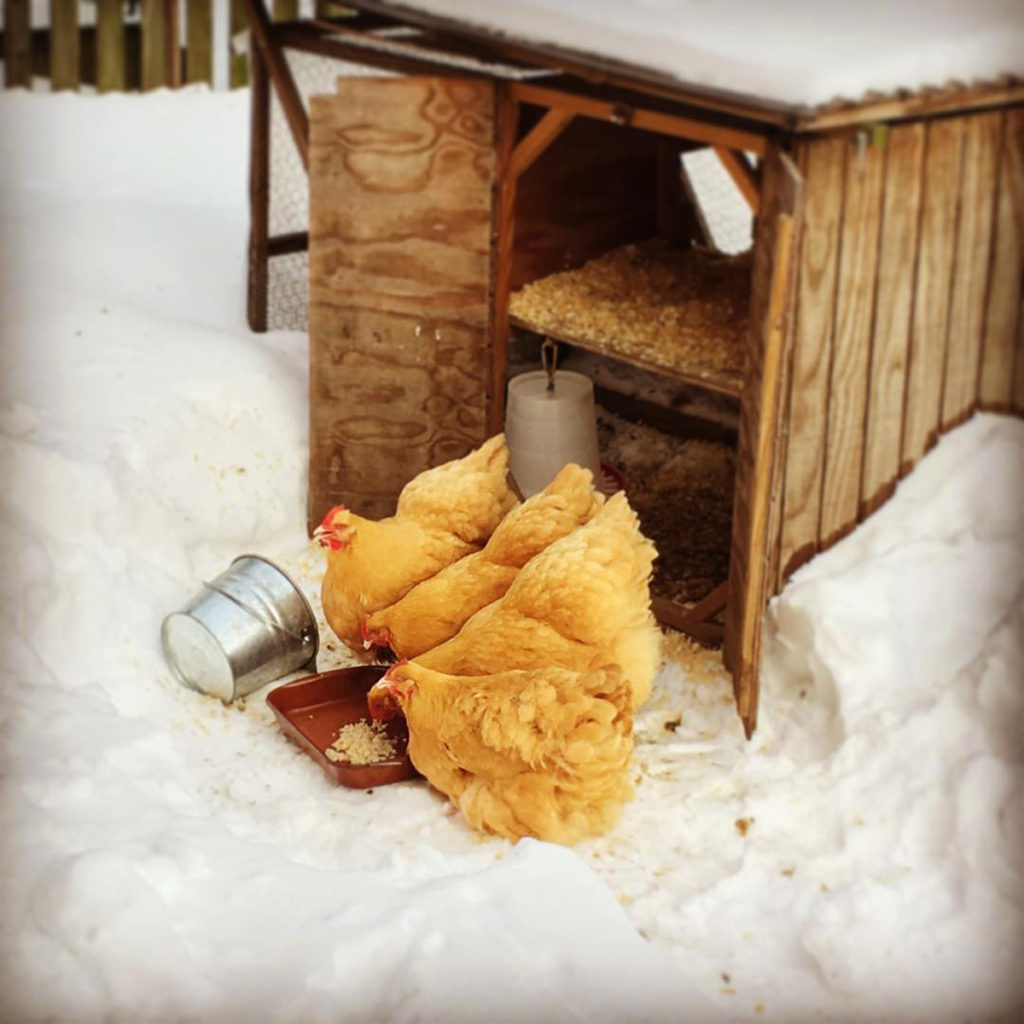Blogger Sandy Cryder shares her adventures with her very first flock of chickens.
The four Buff Orpington hens in my first flock were beautiful! Large bodied; warm, golden, buff colored feathers; heavy, feathered breasts; full, downy Fluffs; Red wattles and single combs. They lay large, brown eggs starting between 5-7 months of age. Buffs are winter hardy and are raised for both meat and eggs. I chose this breed because I wanted winter-hardy layers who would be good-tempered, docile pets.
First Choice
When I read the description of Buff Orpingtons I immediately thought “here’s my first choice breed!” And they lived up to all the good qualities described. I was able to train them to eat from my hand, they were fairly easy to handle, and they laid year-round, except… when they went broody! I missed or overlooked this section of the breed description: they make excellent brooders and mothers.
Broodiness
Here is what fellow blogger Claire Woods has to say about broodiness:
“A broody hen is a hen which wants their eggs to hatch. She will sit on top of her eggs (and others which she’s stolen) all day long in attempt to hatch them. Clearly, if there is no rooster involved then the eggs won’t be fertile and she can sit on top of the eggs for the rest of her life but they still won’t hatch! There is no exact science to exactly what makes a hen go broody- it’s a combination of their hormones, instinct and maturity”
And so, once the pullets grew up and began laying, they started to go broody on a regular basis. This cut down on egg production for a couple of reasons. First, because I had such a small flock, there was only one nesting box in our small coop and ‘Broody’ defended it, trying to keep others from using it. Second, with one hen out of production, we were down to three layers who, on average, were laying 4-5 eggs per week.
As time went by, their periods of broodiness became longer, and two were often broody at the same time. Researching methods to break broody hens filled my spare time! There are many suggested methods:
- Traditional farmers’ method: soak the hen in the rain barrel a couple of times a day. (I used a wash tub; this method did not work.)
- Remove eggs frequently throughout the day (No impact on broodiness)
- Put ice packs in the nest (No results)
- Close the coop and do not allow access (This resulted in the non-broody hens laying eggs in random spots around the yard.)
- Isolate the hen in a cage with no bedding (Like jail for chickens; this did not work.)
A couple of these techniques use chilling to lower the hen’s body temperature. However, research has shown that a broody hen’s body temperature is not significantly different from hens that are laying.

Photo by author.
Help Broody Hens Stay Healthy
One of the significant impacts of brooding for long periods of time is that broody hens do not take care of their basic needs. They do not eat enough; they don’t exercise; and, most significantly for me, they don’t dust bathe.
The periods of broodiness in one of my Buffs extended from days to weeks, and soon her fluff looked like she had been sitting in a pile of dirt. When I carefully examined her, I was horrified to see little, tiny black specs all over her AND strange, hard white clusters around the base of her feathers. Internet research gave me the answer: the hen had both black mites and poultry lice.
Prevention is very important to avoid this terrible problem! Keep your coop clean and dry, set it up so that wild birds and rats don’t have access, and provide adequate dust bathing access to your hens.
Once the infestation has hit your birds, there are lots and lots of suggestions on the internet that profess to be the best method to end it. I tried them all:
- Dust them with diatomaceous earth (semi-effective)
- Bath them and blow them dry (The hens loved the blow drying but ultimately, this didn’t work)
- Dust them with powdered sulfur (brimstone) (My favorite method and the one that actually did work.)

The First Egg!! Photo by author.
Sandy Cryder is a Central Ohio transplant, happily living in Lauraville, a neighborhood in Northeast Baltimore, MD. A descendant of generations of farmers (including her paternal grandparents), Sandy takes great delight in keeping a flock of chickens in the backyard. When not tending to her chickens, she is busy shape note singing, learning Spanish, reading, writing, drawing and knitting. You can follow her through her website or Instagram.













2 Comments
I do the “chicken jail” in a wire dog crate, but it has to be done in combination with other things. Broody hens need several key elements to remain broody – dark, warm and quiet. Remove those aspects of it and I break my hens of broody. I have a wire crate with hardware cloth on the bottom to keep her feed from going through the crate, I elevate it on some 2×4’s in the garage, put in food & water but no roosting pole or nesting material, turn the fluorescent lights on 24/7, turn on a boombox playing classic rock and leave her alone. If it’s warm weather she gets a box fan turned to medium or high and aimed at her from a few feet away. I let her out with the flock on day 3 and if she heads back to the coop and the nesting box she goes back in the crate for another 3 days. Hasn’t failed me yet!
The only cure I could figure out for a broody hen is to sneak a couple chicks under in the middle of the night. Boom, just like that, she went from broody to mommy.